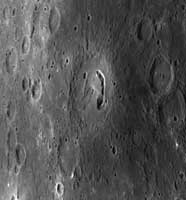|
COMETS EARTH JUPITER KUIPER BELT MARS MERCURY METEORITES NEPTUNE OORT CLOUD PLUTO SATURN SOLAR SYSTEM SPACE SUN URANUS VENUS ORDER PRINTS
PHOTO CATEGORIES SCIENCEVIEWS AMERICAN INDIAN AMPHIBIANS BIRDS BUGS FINE ART FOSSILS THE ISLANDS HISTORICAL PHOTOS MAMMALS OTHER PARKS PLANTS RELIGIOUS REPTILES SCIENCEVIEWS PRINTS
|
Related Documents
Download Options
Date Acquired: September 29, 2009 The unnamed crater in the center of the image, viewed at close range for the first time yesterday during MESSENGERís third flyby of Mercury, displays an arc-shaped depression known as a pit crater on its floor. This pit crater is similar to those seen in crater Beckett and crater Gibran imaged during MESSENGERís first Mercury flyby in January 2008 and in crater Lermontov, observed by both Mariner 10 and by MESSENGER during its second flyby (October 2008). Impact craters on Mercury that host pit craters in their interiors have been named pit-floor craters. Unlike impact craters, pit craters are rimless, often irregularly shaped, and steep-sided, and they display no associated ejecta or lava flows but are typically distinctive in color. Thought to be evidence of shallow magmatic activity, pit craters may have formed when subsurface magma drained elsewhere and left a roof area unsupported, leading to collapse and the formation of the pit. In this example, the southern area of the pit appears to have two or more floor levels. The discovery of multiple pit-floor craters augments a growing body of evidence that volcanic activity was widespread in the geologic evolution of Mercury's crust. Credit: NASA/Johns Hopkins University Applied Physics Laboratory/Carnegie Institution of Washington |
